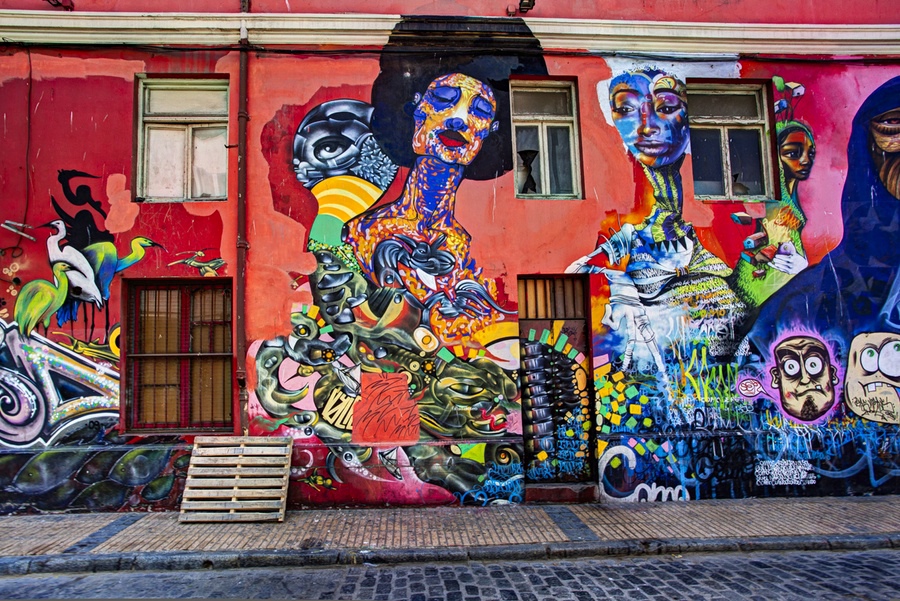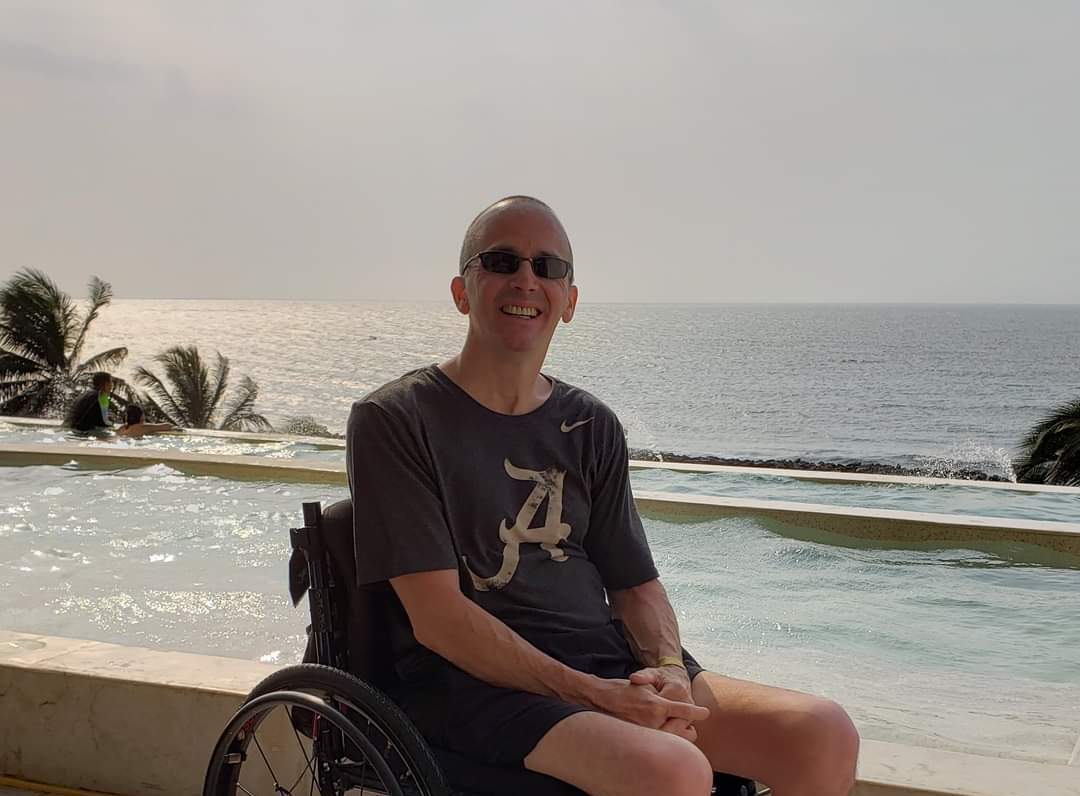It would not be my first trip to South America. In years past, many a day was spent on the prominent avenues of Buenos Aires, Argentina. However, it would be my first trip south injured in a wheelchair. A graduate student at University of Pennsylvania, as part of their MSOD program, I signed up for a course taught in Chile – meant to give students a better understanding of one of the most thriving economies in South America. So many questions arose in my head: How would the flight go; what will the hotel room and bathroom be like; how accessible is Santiago; will I be able to attend all planned program events; will they accept my injury and be helpful, and most of all, how will my overall experience be in Chile?
At first, UPenn did not want to allow me to sign-up for the course. Alan Barstow, Director of MSOD, was not in favor me attending the trip, suggesting perhaps I choose another course. Horrific discrimination aside, I laughed off his ignorance and sought the permission of the professor, who ultimately had the final decision. He was an intelligent jolly German who, after a short conversation on the phone, granted me permission. After all, he would be facing all the same concerns as me. I have since left the program. If you are a well connected tier-four school student with a 2.3 GPA but are willing to pay, they will find you a spot. I went there to be surrounded by the brightest minds, not the dullest money could buy.
After all, upon writing this article, the program has gone downhill and is approaching its last breath. Alan Barstow, an unpublished Columbia elitist, wholly unqualified to direct anything, has methodically ruined the program – becoming a fraternity of corporate Ivy-Tower sycophants who gladly apply brown lipstick and write the check – thus causing a brain-drain to a former colleague of his, Larry Star – now a UPenn competitor, running a similar program at Jefferson University in Philadelphia. As all things in life are for a reason, as there are no mistakes in life – after becoming an esteemed Ivy-League dropout, I went on to write Unbreakable Mind, now selling worldwide. It can be found on Amazon, iTunes, Kindle and Audible.
With so much planned by the university the trip required especially meticulous planning. We all had to find our own way of transportation to Santiago – instructed to arrive within a twenty-four hour period. Luckily I knew another participant who lived not far from my home and was willing to let me travel with him to the airport. In the end, a group of us all reserved the same flight from Baltimore, Maryland to Santiago, Chile. The first glowingly obvious fact to pay attention: Chile is in South America, the Southern Hemisphere, and has opposite seasons as the US. So, while it is warm and summer in North America, it is cold and winter in South America. That means if I could escape for a day I could possibly adaptive ski.
Flight itinerary sussed, it was time to prepare for the trip. Packing was not difficult for me as prior I was a corporate traveler, on the road 90% most months. Packing medical supplies only required multiplying the # days of trip by # needed for each item, per diem. Proper planning for the flight was a bit more complicated. Years ago when I left the hospital I decided I would heal naturally, without any prescribed medications or contraptions attached to my body, which meant I had no urine bag attached to my leg. Once getting past the idea of catheterizing on the plane in front of strangers, anxiety of other bathroom functions set-in. All that preparation made for a successful first flight – a 500-pound gorilla off my back.
When we arrived at Santiago International Airport everything was a chaotic zoo. People, as far as the eye could see, were jockeying for position at the luggage carousels like hornets protecting a nest. We tried searching for the immigration area to no avail – Doing the Dirty Dishes of life! Where normally there would be an area for diplomats, crew and injured to escape the public mayhem, it did not exist. It was the Wild West: my first experience in an over-crowded second-world airport, quickly becoming long on the tooth. Once sorted with luggage and immigration, we tried finding the group for transport to the hotel. With no group in sight, we decided on a taxi. This was an omen of complications soon to arrive.
Only ten minutes into the taxi ride and it was very quickly evident we were in a developing country. The entire ride on the highway into city center poor shanty-towns peppered the landscape along the hungry Mapocho River (Rio Mapocho),filled with plastic and other rubbish. It begins in the Andes Mountains and flows into the city, dividing the capital into two. This foreground is shadowed only by the power and wealth of new economic development in the background, including the famous Great Santiago Tower (Gran Torre Santiago), at a cost of USD $1 billion. At 300-meters high, it is the tallest building in Latin America and second in the Sothern Hemisphere. Its six floors of shopping make for an eye-catching day.
Mayhem aside, it was nice to finally start feeling the cosmic energy and vibrant vigor of South America. There is this certain familiar comforting feel you get when there, as if you just entered an old friend’s house for a family sit-down meal together. It is no surprise then that their culture is so hot and spicy; food and dance included. Latinos are a warm-blooded group, passionate and emotional – the men are overly filled with a peculiar brand of machismo, as if always on stage. As well, the women, not lacking in their own unique inner special flare, with their fragile psyche always front-an-center on display, are sure to let you know what they are thinking. Taking it all in, I was finally in Santiago, a place I longed to visit.
Santiago, literally “St. James,” also known as Santiago de Chile, Chile’s largest and most densely populated city, its capital, part of the Santiago Metropolitan Region – with a total population of seven million residents, home of well-known poet Pablo Neruda – sits surrounded by stunning snow-capped mountains (Andes and Chilean Coast Range), entirely in the country’s Central Valley, is unlike any other city I have visited. It is the political, cultural and financial axis of the country – making Santiago one of the largest and critically important cities in the Americas. It is also home to many regional headquarters of global companies, only adding to the multi-cultural feel of the city, its inhabitants and neighborhoods.
Founded in 1541 by the Spanish conqueror Pedro de Valdivia, it has been the capital of Chile since colonial times. Though most parts of the government are located in Santiago, Congress meets in nearby Valparaiso. The city is very welcoming, with many parks and neighborhoods to visit and enjoy. It is within one hour of the mountains and Pacific Ocean. Chile’s famed wine vineyards are also only a short drive away. A seductive and charming city, its winding streets are dotted with astonishing neoclassical architecture, art-deco, neo-gothic, and other styles ascetically pleasing to the eye. Everywhere you go in the city there is a special ambiance in the air – and a bit of smog too, as the mountains trap pollution.
The capital is separated into districts (comunas) and further into neighborhoods (barrios), each with its own distinct lively character. As good friends live in Las Condes, an area of upper income households, I visited but we soon left for an area with a bit more excitement. By far my favorite barrio is Bellavista, a Bohemian area with lots of street art and performers, as well as amazing night life. The barrio is super-energetic and animated, filled with great bars and restaurants for dining outside (winter is mild enough to still sit outside with LP lamps) with friends. Pablo Neruda, famed Chilean poet, has a home here: La Chascona. The barrio also provides entry to Santiago’s Metropolitan Park – with amazing city panorama.
As we were there on a university program, the focus was not so much on enjoyment in the city (mine was) but rather the budding economy and industries that dominated that arena. One day we had lunch at the Union League of Santiago (Club de la Union), a key influential institution in Chile’s history and future. In its heyday it had over 10,000 members, literally making it the center of Santiago’s public affairs and high-society. I could only imagine what the group of influential heavyweights joining me for lunch thought of me catheterizing at the table (was too involved to get to the loo in time). At one point, Oscar, the manager from South Africa, had to physically carry me to the toilet – the door dated to 1925.
Authoritative buildings and pretentious titles aside, it was time to see Chile outside the big city. One day we visited the largest copper mine in the world, run by Codelco – nationalized in 1971 as a state owned mining company. We also visited a private farm where artisan cheeses were produced for export, mainly goat. The world renowned Chilean vineyards are not a far drive from the city. One day was spent at a boutique winery, where the tasting was generous and food gourmet. By far, my favorite excursion was our trip to Valparaiso, the coastal port city most well known for its street art, steep hills and colorful clifftop homes. European immigrants left their mark on local design, mostly nearby Plaza Sotomayor.
On our one free day I decided to hire a private driver for eight hours to take me to diverse sites outside Providencia district limits. My driver, Terod, with his non-existent English and my sub-par Espanol, taxied me to every possible spot a photo could be taken. As skiing was out, our first stop was gorgeous Parque Bustamante, filled with bold designs and cozy cafes, a great place to warm up with a hot drink outside in the brilliant winter sun. We also visited Bellas Artes, Lastarria, Yungay and Barrio Brasil – all very trendy and fashionable barrios, including urban art installations and various museums. The center of Santiago, Centro Historico, home to Plaza de Armas, includes Cathedral of Santiago and National Historic Museum.
As Chile is filled with diverse terrain and old buildings with small doorways and lots of stairs, it can be quite challenging to navigate unassisted in a wheelchair – there are hazards most everywhere you look. Though I did not use the metro, they are in the process of making subway lines more accessible. Some buildings have ramps but the majority does not. New buses have access ramps and spaces for handicap travelers, otherwise you roll the dice. Still, buildings there have little to no access for disabled travelers. We stayed at an international hotel and even there, in the lobby, I could not access a bathroom stall. Chile is a wonderful country, one I will return to one day, hopefully next time standing upright – walking.
Travel Blog: Click here.
Spiritual Blog: Click here.
Book: Unbreakable Mind. (Print, Kindle, Audio)
Doing The Dirty Dishes Podcast: Watch or listen to episodes and subscribe: Spotify, Apple Podcast, Buzzsprout. Also available on Google Podcast, iHeart, Tunein, Amazon Alexa and Stitcher.
Doing The Dirty Dishes YouTube channel – watch and subscribe.
Social Media links: Twitter, Instagram and Linkedin.
Travel Blog links: Covid-19 stranded in NYC JFK and Maine – also travel stories on Ireland, Spain, Sweden, Belgium, Iceland, Colombia (Espanol version), Amsterdam, Germany, New Hampshire, TN and NYC.
Personal Website link where you can also find my book, photos of my travels and updates on current projects.
Thank you for your love and support.

